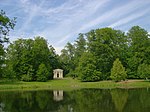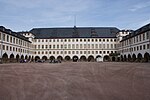Museum of Nature Gotha

The Museum of Nature Gotha (German - Museum der Natur Gotha) is a museum in the German city of Gotha. Since 2004 it has been one of four museums run by the Schloss Friedenstein Foundation Gotha (Stiftung Schloss Friedenstein Gotha), named after the Schloss Friedenstein in the city. Particularly notable are the 1952-1954 hunting and animal-scene diorama backgrounds created by Friedrich Reimann, who also designed the murals in the entrance hall and stairwell. Its collections cover geology, palaeontology and zoology and were begun in the 17th century by the Dukes of Saxe-Gotha-Altenburg. When they and the ducal art collections outgrew the Schloss, Ernest II, Duke of Saxe-Coburg and Gotha built a new Ducal Museum for the paintings, antiquities, plaster casts and the nature cabinet between 1864 and 1879. After much of the art collections were looted by the Soviets in 1945, the natural science collections were moved into the Ducal Museum and remained there after most of the art returned in 1956, being expanded by the addition of the Naturkundliche Heimatmuseum's collections. After being remodelled, the former Ducal Museum building reopened on 1 August 1954 as the Biologische Zentralmuseum (Central Biological Museum). Thuringia's largest natural history museum, it was later renamed the Naturkundemuseum (Natural History Museum) before taking on its present name in 1971. The natural history, geology and palaeontology collections returned to the Schloss in 2010, where they still reside.
Excerpt from the Wikipedia article Museum of Nature Gotha (License: CC BY-SA 3.0, Authors, Images).Museum of Nature Gotha
Kunstmühlenweg,
Geographical coordinates (GPS) Address Nearby Places Show on map
Geographical coordinates (GPS)
| Latitude | Longitude |
|---|---|
| N 50.943333333333 ° | E 10.705833333333 ° |
Address
Englischer Garten Gotha (Schlosspark Gotha)
Kunstmühlenweg
99867 , Siedlung Mittelhausen
Thuringia, Germany
Open on Google Maps










